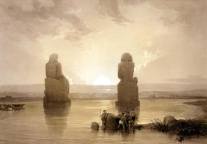 The Memnon Statue also called the "singing statue", stands in Western Thebes as one of the two colossal figures that constitute the last remnants of Amenophis III's funerary temple. Later pharaohs demolished the original temple, which was 2000 feet (600 metres) long (Champollion, 130), in order to use the material to build the emperor Merneptah's mortuary temple. Both of the statues are 65 feet (20 metres) high and are supposed to be the likeness of Amenophis III (Champollion, 130). Greek visitors, however, thought the colossi were Memnon, son of Eos and Tithonus, who killed Antilochus during the Trojan war.
The Memnon Statue also called the "singing statue", stands in Western Thebes as one of the two colossal figures that constitute the last remnants of Amenophis III's funerary temple. Later pharaohs demolished the original temple, which was 2000 feet (600 metres) long (Champollion, 130), in order to use the material to build the emperor Merneptah's mortuary temple. Both of the statues are 65 feet (20 metres) high and are supposed to be the likeness of Amenophis III (Champollion, 130). Greek visitors, however, thought the colossi were Memnon, son of Eos and Tithonus, who killed Antilochus during the Trojan war.
When the northern statue started emitting sounds after an earthquake in 27 BC, the Greeks thought Memnon was moaning a salutation to his mother, the goddess Aurora. In reality, the earthquake damaged the statue so that changes in humidity and temperature at dawn caused an internal vibration, which then produced the strange singing sound. The voice disappeared when Emperor Septimius Severus repaired the damage in AD 199, but not before the phenomenon attracted a large number of tourists. The Greek geographer Strabo first wrote about the "singing statue" in Geographica, which was written after his expedition to Egypt that began in 25 BC. In AD 130, Emperor Hadrian and his wife spent several days by the statues, and according to the poetess Balbilla's inscription on the leg of one of the colossi, the northern statue sang for the emperor three times as a symbol of the Gods' respect (David, 80).
Carlyle contrasts the singing of the Statue of Memnon with the natural talent found in many of his contemporary artists. He explains that the statue sang in harmony with nature and produced a much softer beauty than "the fierce clashing of cymbals, and shouting of multitudes" that Carlyle saw in the art (specifically literature) around him. Carlyle also connects the singing of the Statue of Memnon with light, since the statue would sing only with the coming of the sun. By being in touch with light, art can use the beauty of nature to its own purposes, since "the meek, silent Light can mould, create and purify all Nature." Because an earthquake started the statue's song and the sun reawakened it each day, the statue sang in harmony with both light and nature, and was able to create a more perfect beauty than that created by the artists that Carlyle criticizes in "Signs of the Times."
[Other Victorian authors who refer to Memnon include Alfred Lord Tennyson (in "The Palace of Art"), Oscar Wilde (in "The Sphinx"), Walter Pater (in The Renaissance), and the little-known George Heath (in "Man o' Mow") — George P. Landow.]
References
Champollion, Hervé and Diane Sarofim Harlé. Egypt: Stones of Light. New York: Harry N. Abrams, Inc., 2003.
David, Rosalie. Discovering Ancient Egypt. New York: Facts on File, 1993.
Last modified 30 March 2009